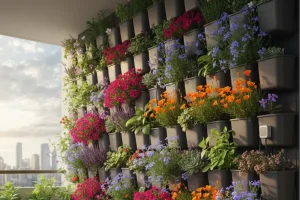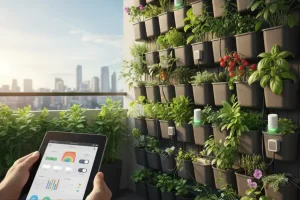Want your kids to fall in love with plants without sacrificing your walls, floors, or sanity? A family-friendly vertical garden turns a blank fence or indoor wall into a living classroom. It’s compact, safe, and designed so little hands can help with real tasks: watering, harvesting, and even simple pest checks.
This post shows you how to plan a kid-safe layout, choose non-toxic, sensory-rich plants, and set up a simple weekly routine that keeps the garden thriving. We’ll also cover height guidelines, hardware safety, spill control, and hygiene for edible harvests.
Why build a family-friendly vertical garden?
- Space-smart: Grow more in small areas—balconies, patios, fence lines, or a sunny kitchen wall.
- Hands-on learning: Kids see seeds sprout, flowers turn to fruit, and pollinators at work.
- Healthy snacking: Fresh herbs and edible flowers make produce exciting.
- Easy maintenance: Vertical systems put plants at eye level, so chores take minutes, not hours.
The big picture: design goals that matter
- Safety first: Stable frames, rounded edges, secure anchors, and non-toxic plant choices.
- Kid access: A reachable “kid zone” for watering and harvesting (no stools required).
- Simple systems: Fewer parts to break, easy to clean, and forgiving of beginner mistakes.
- Sensory engagement: Plants that invite touch, smell, sound, taste, and color exploration.
- Clear routines: Short, repeatable tasks so kids feel successful and the garden stays healthy.
Pick the right system (with kids in mind)
Good options
- Stacked rail planters or troughs: Rigid, sturdy, and easy to remove for cleaning.
- Modular pocket panels (rigid plastic or sturdy felt with liners): Keep to 2–3 columns for reachability.
- Ladder-style shelves with saucers: Simple to assemble; great for soil-based pots.
- Tower planters with wide bases: Look for anti-tip features and heavy lower tiers.
Features to prioritize
- Anchors & anti-tip: Use wall anchors matched to your surface (masonry, drywall, or wood). For towers, add sandbags or a ground screw at the base outdoors.
- Rounded corners & edge guards: Foam corner protectors or sanded wood edges prevent bumps.
- Catch trays & splash mats: Place a tray under each tier; add a waterproof mat on the floor.
- Color coding: Mark one row with colored tape so kids know “this is our row to water/harvest.”
Height guide
- Lowest tier: 24–30 in (60–76 cm) from the ground to keep toddlers from soil digging and pet snacking.
- Kid zone: 30–40 in (76–102 cm) high—perfect for ages ~4–9 to water and pick.
- Adult zone: 40–60 in (102–152 cm)—pruning, trellising, or plants you’d rather kids just admire.
Safe, sensory-rich plant list (non-toxic + fun)
Always double-check plant names at purchase; stick to edible or non-toxic species and skip anything spiky.
Herbs (tasty, fragrant, forgiving)
- Basil, parsley, chives, mint, thyme, lemon balm.
- Lavender for scent (use culinary types; small quantities as garnish).
- Catnip if you have curious cats—happy pet, happy kids!
Edible flowers & kid favorites
- Nasturtium (peppery leaves/flowers kids love to try), viola/pansy, calendula (petals in salads), snapdragon (fun “dragon mouth” game—teach gentle touch), sunflower ‘Teddy Bear’ (dwarf, fuzzy look).
- Strawberries (everbearing) and sugar snap peas on a mini trellis.
Soft-touch & sounds
- Lamb’s ear (Stachys byzantina)—silvery, velvety leaves.
- Ornamental grasses (dwarf, non-sharp) for rustling sound—great at the top tier.
Plants to avoid around kids/pets
- Oleander, foxglove, castor bean, lantana, philodendron, dieffenbachia, nightshade ornamentals.
- Cacti/agaves (spines) and strongly allergenic plants if anyone has known sensitivities.
Media, containers, and fertilizers (keep it clean and simple)
- Containers: 1–3 L pots with drainage holes and secure saucers. Choose lightweight plastic or food-safe resin (no shattering).
- Potting mix: 60% high-quality potting mix + 30% perlite/fine bark + 10% compost for nutrients and drainage.
- Fertilizer: Use organic, slow-release pellets in the soil plus a gentle liquid feed at ¼ strength every 2–3 weeks during active growth. Store all fertilizers out of reach.
- Watering gear: Kid-sized 1–2 L watering can or a hand pump mister (fine spray, not a jet). Label the can with a sticker—kids love “their” tool.
Layout that teaches without chaos
- Row themes:
- Row 1 (kid zone): “Pick & Snack” (strawberries, peas, nasturtium, chives)
- Row 2: “Smell & Touch” (lemon balm, lavender, lamb’s ear)
- Row 3 (adult zone): “Cook & Dry” (thyme, parsley, basil for bulk harvest)
- Row 1 (kid zone): “Pick & Snack” (strawberries, peas, nasturtium, chives)
- Visual labels: Waterproof plant tags with icons (strawberry, herbs, flowers).
- Harvest basket: A small colander or basket hung on a hook for kids to collect their “wins.”
Simple weekly routine (10–15 minutes)
Monday – Water & Watch (kids lead)
- Check the top inch of soil: dry = water; moist = skip.
- Water at the base of plants until a little drains into the saucer. Empty saucers after 30 minutes.
Wednesday – Groom & Smell (shared)
- Pinch spent blooms on violas/calendula.
- Rub a leaf gently (mint, lemon balm) and describe the scent.
- Count bees/butterflies if outdoors (observe from a step back).
Friday – Harvest & Taste (kids lead with supervision)
- Snip herbs with blunt-tip scissors or pinch with fingers.
- Pick only ripe strawberries or peas; leave small ones to “grow for next Friday.”
First weekend of the month – Deep Care (adult lead)
- Top up slow-release fertilizer if due, trim leggy stems, wipe leaves with a damp cloth, and rinse trays.
- Quick pest patrol (see below).
Pest control the family-friendly way
- Prevention: Airflow (small clip fan indoors), don’t overwater, and avoid leaf-wetting at night.
- Hand removal: For aphids, a gentle water spray or a soapy water wipe (1–2 drops of mild soap in a liter of water) on non-edible ornamentals. Rinse after.
- Neem or insecticidal soap (edible-safe): Use sparingly, follow labels, and avoid spraying when kids/pets are nearby.
- Quarantine: New plants live on the side for a week before joining the main wall.
Hygiene and allergy basics (quick but important)
- Wash hands after gardening and rinse all harvests under clean water.
- If anyone has bee/wasp allergies, place highly attractive flowers (like lavender) higher on the wall or out of doorways, and harvest in the early morning when fewer pollinators are active.
- Skip greywater on kid-harvested edibles; stick to fresh water for anything they’ll eat raw.
- Store scissors, fertilizer, and any sprays locked or out of reach.
Step-by-step: set it up this weekend
Tools & supplies
- Wall anchors and screws (rated for your surface)
- Level, drill/driver, sandpaper or corner guards
- 2–3 rail planters or a ladder shelf with saucers
- 10–12 pots (1–3 L), potting mix, perlite/bark, compost
- Slow-release organic fertilizer & gentle liquid feed
- Kid-sized watering can, blunt-tip scissors, labels/tags
- Splash mat or boot tray to catch drips
Saturday morning – Mount & protect
- Mark stud locations (or use proper anchors).
- Mount rails/shelves level; confirm no wobble.
- Add corner guards and place a splash mat beneath.
Saturday afternoon – Pot & arrange
- Mix soil (60/30/10) and fill pots 80–90%.
- Plant herbs/flowers; water thoroughly.
- Position by zones: Pick & Snack low, Smell & Touch mid, Cook & Dry high.
- Add labels with icons and kids’ names if you like.
Sunday – Train the routine
- Show the “finger test” for soil moisture.
- Practice “slow pours” with the watering can.
- Set up the weekly chart (see below) and assign garden captain of the week.
Troubleshooting: quick fixes
- Droopy plants every afternoon: Normal in heat; if they’re still droopy next morning, increase watering frequency slightly.
- Yellow lower leaves: Back off watering; check drainage; consider a light feeding.
- Leggy stems, few flowers: Plants need more light. Move the garden or add a small LED bar 8–12 in above the foliage (12–14 hours/day).
- Spills on the floor: Use a smaller watering can and remind “slow pour, count to five.” Add deeper saucers.
- Kids losing interest: Introduce quick wins—radishes in a pot, fast-growing microgreens, or a weekly “mystery smell” leaf.
Common mistakes to avoid (and how to fix them)
1) Mounting too low
- Problem: Pets and toddlers treat it as a sandbox.
- Fix: Start the lowest tier at 24–30 in off the floor; add a splash mat.
2) Mixing toxic and edible plants
- Problem: Confusion and potential risk.
- Fix: Keep the whole display edible or non-toxic; label clearly.
3) Overcomplicated irrigation
- Problem: Leaks, clogs, and frustration.
- Fix: Start with hand watering or a simple drip line with a timer. Upgrade later.
4) Sharp tools within reach
- Problem: Safety hazard.
- Fix: Use blunt-tip scissors for kids and store pruners high.
5) Leaf-wetting at night
- Problem: Mildew.
- Fix: Water morning or mid-day at the base of plants.
6) No airflow indoors
- Problem: Fungus gnats and mildew.
- Fix: A quiet clip fan on low, pointed across (not at) the plants.
Easy kid-approved recipes (bonus motivation)
- Herb confetti: Finely snip chives, parsley, and basil; sprinkle over eggs, rice, or pizza.
- Nasturtium tacos: Fill big nasturtium leaves with cream cheese, shredded carrots, and a pea pod—roll and crunch.
- Calendula “sunshine salt”: Mix crumbled petals with coarse salt for bright, floral seasoning.
Wrap-up: grow curiosity on a wall
A family-friendly vertical garden is more than decoration; it’s a tiny ecosystem at kid height. Choose non-toxic plants, mount sturdy, spill-smart hardware, and keep chores short and predictable. With a reachable “kid zone,” a few sensory plants, and a simple chart, your children will take real ownership—watering, harvesting, and proudly serving herbs they grew themselves.




